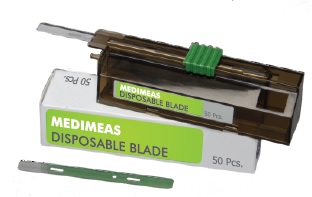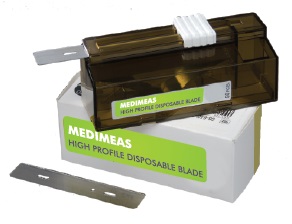Made in Japan for Medimeas Instruments, these disposable microtome blades are specially designed to produce uniform thickness tissue sections. Each blade undergoes a sophisticated heating process, excellent polishing and state-of-the-art coating technique resulting in exceptional quality. Online orders are accepted pan India.

Low Profile Microtome Blades
- Specially honed and coated for incredible precision and durability
- Durability saves lab time and money
- Ideal for sectioning soft tissues

High Profile Microtome Blades
- Specially honed and coated for incredible precision and durability
- Durability saves lab time and money
- Ideal for sectioning hard tissues
| Element | Percentage |
|---|---|
| Carbon | 0.65-0.70 |
| Silicon | 0.20-0.35 |
| Manganese | 0.60-0.75 |
| Phosphorous | 0.025 Max |
| Sulphur | 0.020 Max |
| Nickle | 0.50 Max |
| Chromium | 12.70-13.50 |
| Iron | Rest |
| Edge Angle (deg) | Length (mm) | Width (mm) | Thickness (mm) | |
|---|---|---|---|---|
| Low Profile | 35 | 80 | 8 | 0.25 |
| High Profile | 35 | 80 | 14 | 0.32 |
Quality Testing Procedures
Blade Edge Condition Checking using Laser Scanning Microscopy
A microtome blade’s cutting ability depends on the condition of the blade edge. A chipped edge makes the blade dull resulting in inferior tissue section quality.
A Laser Scanning Microscope precisely captures the shape of the microtome blade edge for quality control. It has very high detection sensitivity for slopes, enabling 3D observation and measurement of small shape of blade edge.
Retained Austenite Percentage Checking using X-ray Diffractometer
Austenite that does not transform to martensite on quenching is called retained austenite. This retained austenite occurs when the steel is not quenched to a temperature low enough to form 100% martensite. This retained austenite in the microtome blade can cause loss of strength and increased brittleness. An X-ray Diffractometer is used to accurately measure the retained austenite concentrations as low as 0.5%.
Sputter Thickness Uniformity Measurement on Blade Edge using X-ray Fluorescence
In order to increase the strength and durability of microtome blade , a thin film of carbide, nitride, oxide etc is coated on the blade edge using physical vapour deposition. This process is called sputtering. An X-ray Fluroscence is used to precisely measure the sputter thickness uniformity for producing consistent quality blades
Microtome Blade edge topography analysis using Atomic Force microscopy
A high resolution three dimensional topographic information of the blade edge is studied using Atomic Force Microscopy to ensure the sharpness of the blade throughout the edge.